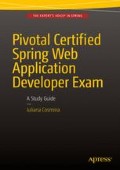Abstract
As time went by, and more and more services could remotely use web applications, the web applications became more complex—and designing and implementing them became a cumbersome process. Most applications imply creating objects and passing them through several states, or creating objects depending on each other. Spring Web Flow (SWF) is a component of the Spring Framework’s web stack that was created to help develop complex applications by reducing the difficulty in development.
Access this chapter
Tax calculation will be finalised at checkout
Purchases are for personal use only
Notes
- 1.
The official site of the project ( http://projects.spring.io/spring-webflow/ ) is usually updated late, so it might show an earlier version; the most recent release can be found on the Maven public repositpry site at http://mvnrepository.com .
- 2.
The code for the class is publicly available on GitHub at https://github.com/spring-projects/spring-webflow/blob/master/spring-webflow/src/main/java/org/springframework/webflow/mvc/servlet/FlowController.java .
- 3.
The GOTO statement (see https://en.wikipedia.org/wiki/Goto ).
- 4.
- 5.
1. False. This variable is defined in the first requestScope and a state has two requests. Rendering the view is done in the second request. 2. True. As explained earlier. 3. True. var1 and var4 are defined in flashScope; var3 and var5 are defined in the scope of the rendering requestScope. 4. True. var1 is lost because it is defined when entering the state, and if the page is reloaded, entering the page is done only once. So when the page is reloaded, the flash scope is cleaned and var1 is lost.
- 6.
If you want more information about validation groups, the official documentation is a great start; it can be found at https://docs.oracle.com/javaee/7/tutorial/index.html .
- 7.
- 8.
A bug related to mocking subflows; still open and unresolved since version 2.0.6. See https://jira.spring.io/browse/SWF-1079 .
- 9.
Don’t Repeat Yourself.
- 10.
Spring Security page at http://spring.io/spring-security .
- 11.
A full list of authentication technologies that Spring Security integrates with; it can be found at http://docs.spring.io/spring-security/site/docs/current/reference/htmlsingle/#what-is-acegi-security .
- 12.
This type of attack consists of hacking an existing session to execute unauthorized commands in a web application. You can read more about it at https://en.wikipedia.org/wiki/Cross-site_request_forgery .
- 13.
The full list of configuration changes that were made to match Java Configuration is at https://jira.spring.io/browse/SEC-2783 .
- 14.
Read more about MD5 at https://en.wikipedia.org/wiki/MD5 .
- 15.
The project’s official page is at http://projects.spring.io/spring-security-oauth/ .
Author information
Authors and Affiliations
Rights and permissions
Copyright information
© 2015 Iuliana Cosmina
About this chapter
Cite this chapter
Cosmina, I. (2015). Spring Web Flow. In: Pivotal Certified Spring Web Application Developer Exam. Apress, Berkeley, CA. https://doi.org/10.1007/978-1-4842-0808-3_7
Download citation
DOI: https://doi.org/10.1007/978-1-4842-0808-3_7
Publisher Name: Apress, Berkeley, CA
Print ISBN: 978-1-4842-0809-0
Online ISBN: 978-1-4842-0808-3
eBook Packages: Professional and Applied ComputingApress Access BooksProfessional and Applied Computing (R0)

